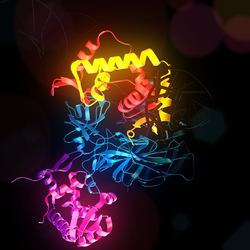| FOXP3 |
|---|
 |
|
| Structures disponibles |
|---|
| PDB | Recherche d'orthologue: PDBe RCSB |
|---|
| Identifiants PDB |
|---|
3QRF, 4WK8 |
|
|
| Identifiants |
|---|
| Aliases | FOXP3 |
|---|
| IDs externes | OMIM: 300292 MGI: 1891436 HomoloGene: 8516 GeneCards: FOXP3 |
|---|
| Position du gène (Homme) |
|---|
 | | Chr. | Chromosome X[1] |
|---|
| | Locus | Xp11.23 | Début | 49,250,438 bp[1] |
|---|
| Fin | 49,270,477 bp[1] |
|---|
|
| Position du gène (Souris) |
|---|
 | | Chr. | X chromosome (souris)[2] |
|---|
| | Locus | X A1.1|X 3.41 cM | Début | 7,439,883 bp[2] |
|---|
| Fin | 7,461,484 bp[2] |
|---|
|
| Expression génétique |
|---|
| Bgee | | Humain | Souris (orthologue) |
|---|
| Fortement exprimé dans | - gonade
- testicule
- tendon of biceps brachii
- ganglion lymphatique
- cæcum
- appendice iléo-cæcal
- sang
- tonsille
- vésicule biliaire
- granulocyte
|
| | Fortement exprimé dans | - urètre
- male urethra
- blastocyste
- embryon
- pharynx
- thymus
- méninges
- tail of embryo
- dentate gyrus of hippocampal formation granule cell
- neural layer of retina
|
| | Plus de données d'expression de référence |
|
|---|
| BioGPS | 
 | | Plus de données d'expression de référence |
|
|---|
|
| Gene Ontology |
|---|
| Fonction moléculaire | - sequence-specific DNA binding
- NF-kappaB binding
- transcription corepressor activity
- Fixation d'acide nucléique
- transcription factor activity, RNA polymerase II distal enhancer sequence-specific binding
- liaison protéique
- liaison d'histone déacétylase
- DNA-binding transcription factor activity
- NFAT protein binding
- liaison d'histone acétyltransférase
- liaison ion métal
- liaison ADN
- protein homodimerization activity
- DNA-binding transcription factor activity, RNA polymerase II-specific
- RNA polymerase II cis-regulatory region sequence-specific DNA binding
| | Composant cellulaire | - noyau
- intracellulaire
- cytoplasme
- nucléoplasme
- complexe macromoléculaire
| | Processus biologique | - negative regulation of cell population proliferation
- negative regulation of NF-kappaB transcription factor activity
- B cell homeostasis
- regulation of isotype switching to IgG isotypes
- myeloid cell homeostasis
- negative regulation of inflammatory response
- positive regulation of interleukin-4 production
- regulation of immunoglobulin production
- regulation of transcription by RNA polymerase II
- regulation of T cell anergy
- negative regulation of interleukin-6 production
- tolerance induction to self antigen
- regulation of transcription, DNA-templated
- negative regulation of DNA-binding transcription factor activity
- positive regulation of T cell tolerance induction
- negative regulation of immune response
- negative regulation of interferon-gamma production
- tolerance induction
- regulatory T cell differentiation
- régulation positive de la transcription dépendante de l'ADN
- negative regulation of interleukin-2 production
- positive regulation of histone acetylation
- negative regulation of interleukin-5 production
- negative regulation of chronic inflammatory response
- CD4-positive, CD25-positive, alpha-beta regulatory T cell differentiation
- positive regulation of transcription by RNA polymerase II
- negative regulation of activated T cell proliferation
- positive regulation of gene expression
- negative regulation of interleukin-4 production
- negative regulation of interleukin-10 production
- negative regulation of tumor necrosis factor production
- T cell homeostasis
- negative regulation of CREB transcription factor activity
- negative regulation of T-helper 17 cell differentiation
- T cell activation
- positive regulation of immature T cell proliferation in thymus
- positive regulation of regulatory T cell differentiation
- negative regulation of transcription by RNA polymerase II
- positive regulation of peripheral T cell tolerance induction
- positive regulation of transforming growth factor beta1 production
- negative regulation of transcription, DNA-templated
- negative regulation of lymphocyte proliferation
- negative regulation of histone acetylation
- negative regulation of interleukin-17 production
- response to virus
- negative regulation of histone deacetylation
- CD4-positive, CD25-positive, alpha-beta regulatory T cell lineage commitment
- positive regulation of CD4-positive, CD25-positive, alpha-beta regulatory T cell differentiation
- negative regulation of T cell proliferation
- Remodelage de la chromatine
- cytokine production
- negative regulation of T cell cytokine production
- negative regulation of isotype switching to IgE isotypes
- T cell receptor signaling pathway
- positive regulation of T cell anergy
- transcription, DNA-templated
- T cell mediated immunity
- negative regulation of gene expression
- morphogenèse d'une structure anatomique
- regulation of Wnt signaling pathway
- regulation of regulatory T cell differentiation
| | Sources:Amigo / QuickGO |
|
| Orthologues |
|---|
| Espèces | Homme | Souris |
|---|
| Entrez | | |
|---|
| Ensembl | | |
|---|
| UniProt | | |
|---|
| RefSeq (mRNA) | | |
|---|
NM_001199347
NM_001199348
NM_054039 |
|
|---|
| RefSeq (protéine) | | |
|---|
NP_001186276
NP_001186277
NP_473380 |
|
|---|
| Localisation (UCSC) | Chr X: 49.25 – 49.27 Mb | Chr X: 7.44 – 7.46 Mb |
|---|
| Publication PubMed | [3] | [4] |
|---|
|
| Wikidata |
| Voir/Editer Humain | Voir/Editer Souris |
|


 Portail de la biologie cellulaire et moléculaire
Portail de la biologie cellulaire et moléculaire 

















